Difference between revisions of "Current driver:RevD"
m (images) |
m |
||
| Line 23: | Line 23: | ||
=== Gradient Rejection === | === Gradient Rejection === | ||
| − | Gradient rejection ability was tested with the default 10 cm diameter single-loop shim coil by applying an external magnetic field from a loosely-coupled coil and measuring the coil current. | + | Gradient rejection ability was tested with the default 10 cm diameter single-loop shim coil by applying an external magnetic field from a loosely-coupled coil, and measuring the resulting shim coil current. |
Pink (channel 4) in the screenshots below is the voltage applied to the coupling coil, while green (channel 2) is the current in the shim coil. | Pink (channel 4) in the screenshots below is the voltage applied to the coupling coil, while green (channel 2) is the current in the shim coil. | ||
Revision as of 14:59, 11 May 2021
Introduction
Revision D of the design is a major change from revision C, with real-time waveform playback, improved control loop performance, and easier assembly.
Design
Similar to revision C, the user's computer communicates with the current driver box: a single digital control board which interfaces with multiple (up to 8) 8-channel amplifiers, each containing a DAC for setting output current, an ADC for monitoring output current, and 8 copies of the analog control loop and power amplifier. Each amplifier consists of two sections: a power board mounted to a heatsink, and a control board mounted to the power board. Power outputs run over ribbon cables to an ODU-MAC White-Line connector for connecting the shim coils. (Block diagram)
Design files: Amp control board: File:Amp ctrl revD1A.zip Amp power board: File:Amp pwr revD1.zip Digital control board: (TBD) Output connector board: (TBD)
Control loop compensation is adjustable for different shim coils by inserting through-hole components into connectors on the amp control board. The Octave/MATLAB script below will recommend component values to use based on your coil parameters and predict the control loop response. File:Current driver compensation.zip
Assembly Instructions
(TBD)
Performance
Bandwidth / Step Response
(TBD on final hardware)
Gradient Rejection
Gradient rejection ability was tested with the default 10 cm diameter single-loop shim coil by applying an external magnetic field from a loosely-coupled coil, and measuring the resulting shim coil current. Pink (channel 4) in the screenshots below is the voltage applied to the coupling coil, while green (channel 2) is the current in the shim coil.
Without shim amplifier: induced voltage (yellow, channel 1)
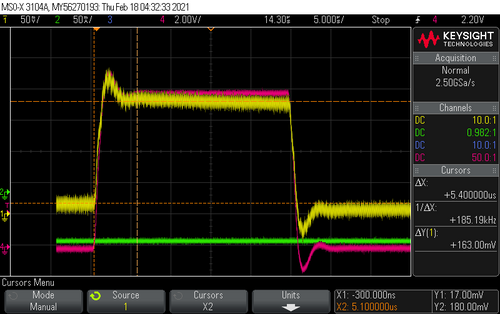
Without shim amplifier: shorted leads
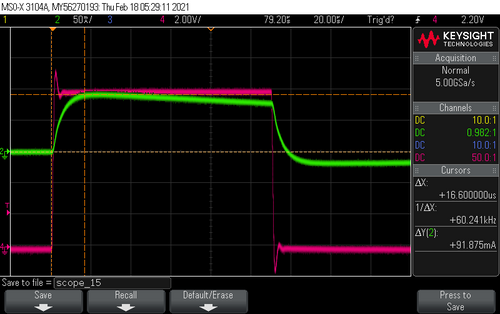
Revision C amplifier:
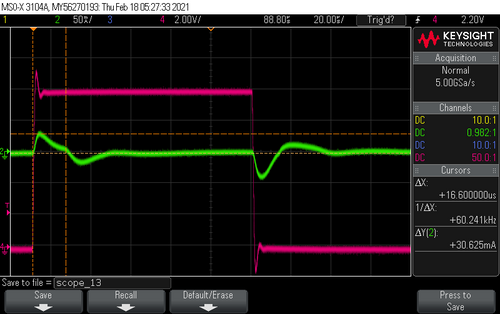
Revision D amplifier:
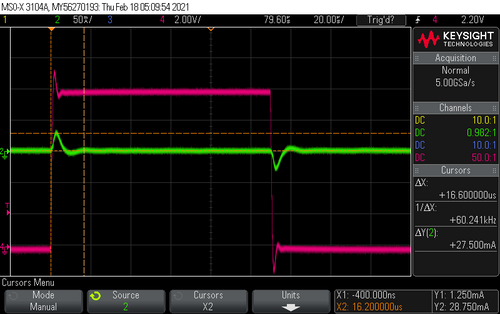
For the test setup, an AE Techron 7224 was used in constant-voltage mode to drive the coupling coil, which consisted of 18 turns of 20 AWG magnet wire wrapped solenoid-style on a TDK-Epcos B64290A0084X038 ferrite core (measured 102 µH @ 100 kHz), intended to increase the inductance of the coupling coil and make higher voltages easier to drive without excessive magnetizing current. The coupling coil was mounted co-axial with the shim coil, strapped to the opposite side of a piece of 1.6 mm FR-4.
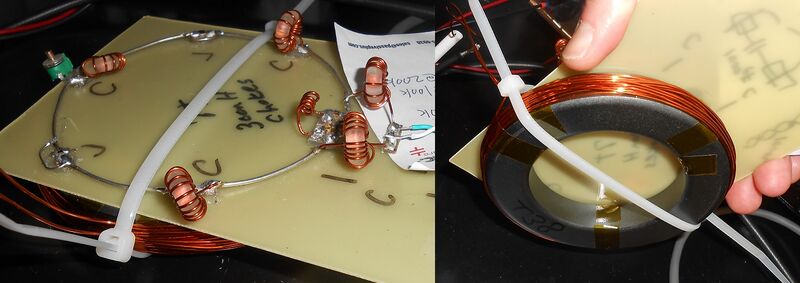
The ferrite core only changed the shim coil's original inductance by +2.3% (2.64 µH -> 2.70 µH without extension leads), and the estimated coupling coefficient from the shim coil to coupling coil was only 1.1% (shim coil inductance dropped from 2.70 µH to 2.67 µH when coupling coil leads were shorted). The original circuit parameters and compensation were therefore not noticeably affected. The extension leads, which increase overall shim coil inductance to 7.9 µH + 1.5Ω @ 100 kHz, were used during the test, as with every test involving this default shim coil, to accurately represent the shim cabling used in the scanner.